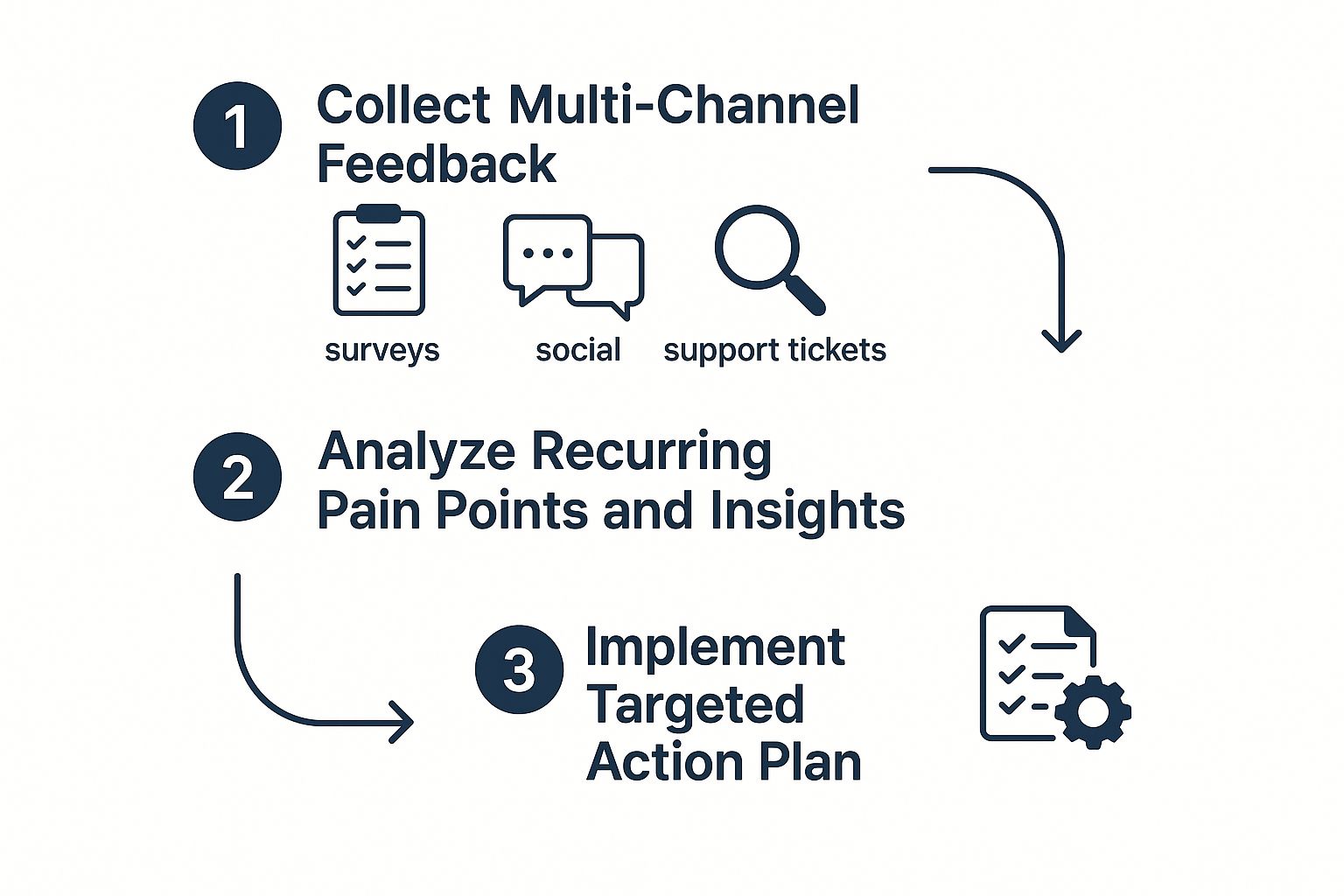If you really want to boost customer satisfaction, you have to think bigger than just putting out fires. It’s about building genuine loyalty—being proactive, personalizing the experience, and actually listening to what your customers are telling you.
This means taking those survey scores and feedback comments and turning them into a company-wide mission to create positive, memorable moments every single time a customer interacts with you.
Why Customer Satisfaction Is a Leading Growth Indicator

It’s tempting to look at customer satisfaction as just another metric on a dashboard—a simple collection of star ratings. But that’s a huge mistake. True customer satisfaction is one of the most reliable predictors of your business’s long-term health. It’s a direct engine for growth.
Happy customers don't just buy once. They come back again and again, tell their friends about you, and become your best marketing asset. In fact, a loyal customer is five times more likely to repurchase from you and forgive a mistake than a new one. That's where the connection to your revenue becomes impossible to ignore.
Before we dive into the specific "how-to," it helps to understand the core components we're working with. These pillars are the foundation of any successful customer satisfaction strategy.
Core Pillars of Modern Customer Satisfaction
| Pillar | Why It Matters for Growth |
|---|---|
| Proactive Support | Solving problems before they happen builds immense trust and shows customers you're truly looking out for them, not just reacting to complaints. |
| Personalization | Making customers feel seen and understood—not like just another number—is what separates a forgettable transaction from a memorable experience. |
| Feedback Loop | Actively collecting and acting on customer feedback is the only way to know what's working and what isn't, turning insights into real improvements. |
| Omnichannel Consistency | Whether it's on your website, via email, or through a chatbot, the experience needs to feel seamless and consistent. A disjointed journey creates friction. |
Mastering these areas is what separates the businesses that just "satisfy" customers from those that delight them.
Beyond the Surface-Level Score
Here’s a hard truth: just keeping your satisfaction score stable isn't good enough. Recent studies show that even while general satisfaction levels look okay, the metrics that really matter—like trust, advocacy, and intent to repurchase—are actually dropping.
This points to a massive gap. Many businesses are meeting basic expectations but completely failing to build the deeper relationships that lock in future revenue. It means that even with decent numbers, you could be slowly bleeding loyalty.
Focusing on how to improve customer satisfaction isn't just about damage control. It's a strategic investment in your company’s future.
A satisfied customer is the best business strategy of all. It’s a direct investment in brand reputation, organic growth, and long-term financial stability.
The Real Impact on Your Bottom Line
When you make creating positive experiences a priority, you're actively building a stronger foundation for growth. Exceptional service essentially turns your customers into a volunteer marketing army.
Their positive reviews and word-of-mouth recommendations are often far more trusted than any ad you could run. This not only makes acquiring new customers cheaper but also drives up the lifetime value of your existing ones.
This investment directly strengthens your customer retention strategies, which are absolutely vital for survival. Once you get the "why," you can dig into the "how" with proven strategies to increase customer satisfaction and start turning these ideas into action.
Turn Customer Feedback into an Action Plan
Listening to your customers is just the start. The real magic happens when you turn what they say into a concrete plan for improvement. To truly understand how to boost customer satisfaction, you need to be actively gathering insights everywhere your customers are. Sending out a single survey once a year just doesn't cut it anymore.
A smart approach mixes quantitative data with those juicy qualitative insights. This means looking past standard metrics like Net Promoter Score (NPS) and Customer Satisfaction (CSAT) scores. You have to dig into the unstructured feedback—the stuff hidden in support tickets, live chat transcripts, and social media comments. Each one gives you a different piece of the puzzle.
Combine Data Sources for a Fuller Picture
To get the complete story, you’ve got to pull information from all your customer touchpoints. A low CSAT score tells you something's off, but a sudden spike in support tickets about a specific bug tells you exactly what's broken.
Think about tapping into these channels:
- Direct Surveys: Use NPS to get a feel for overall loyalty, but also use CSAT or Customer Effort Score (CES) to get immediate feedback after a specific event, like a purchase or a chat with support.
- Support Tickets: Your support inbox is an absolute goldmine. It shows you the most common frustrations and confusing features your customers run into day after day.
- Social Media Monitoring: Keep tabs on brand mentions and key hashtags. Social media is where people share their most honest, unfiltered opinions—both the good and the bad.
This visual breaks down how you can turn all that raw customer feedback into a structured improvement plan.

It’s a continuous loop. The actions you take create new feedback, which then fuels the next round of improvements.
Uncover Recurring Themes and Pain Points
Once you have the data, the real work begins: finding the patterns. You're not just looking for one-off complaints. You're hunting for recurring themes. Are tons of customers getting stuck at checkout? Do support tickets constantly mention a lack of clear instructions for a certain feature?
For an e-commerce brand, maybe you notice a pattern of negative reviews about inconsistent product sizing. That’s not just feedback—it's a bright, flashing sign to update your product pages with better measurements. A simple fix like that could potentially slash your return rate by 20-30%.
By systematically tracking and categorizing feedback, you transform anecdotal complaints into actionable data. This moves your team from a reactive "firefighting" mode to a proactive problem-solving mindset.
If you're a SaaS company, maybe you see a bunch of support requests asking how to do the same task. This probably means a feature is designed poorly or needs better in-app help. That insight can directly shape your product roadmap, pushing a redesign to the top of the list that will cut down on future support tickets and make users happier.
The goal is to let these customer voices guide your strategy. For a deeper dive into this, check out our guide covering customer support best practices. When you create a clear action plan, you prove to customers you’re not just hearing them—you’re listening and taking action.
Redesigning Your Customer Service Experience

It only takes one frustrating support call to undo months of goodwill you've built with a customer. When we talk about redesigning your customer service, it isn't about flashy, one-off gestures. It’s about methodically rooting out friction points and making it dead simple for people to get help.
The goal is to build a support system that feels intuitive and genuinely helpful, not like a maze.
This has never been more important. Today’s customers have sky-high expectations, and the service you provide is a massive part of their buying decision. In fact, 99% of consumers say customer service is a key factor when choosing a brand, and 74% consider it 'very important or essential'. The stakes are incredibly high, as 70% of customers admit they’ll walk away after just two bad experiences. You can dive into the complete findings on customer experience statistics to see just how critical this is.
Build a Seamless Omnichannel System
What's one of the fastest ways to annoy a customer? Make them repeat themselves. An omnichannel support system is the antidote, weaving all your channels—email, live chat, social media, phone calls—into a single, continuous conversation.
Think about it. A customer starts a web chat with an AI bot about a late delivery. The bot gets the order number, but the issue needs a human touch. In a truly seamless system, that chat is handed off to a live agent who already has the full transcript. The customer doesn't have to start from scratch.
This small detail shows you respect their time, which goes a long way toward building satisfaction.
Empower Your Team to Solve Problems Fast
Your support agents are on the front lines, and they can't deliver amazing experiences if their hands are tied by rigid rules. You have to give them the tools, training, and—most importantly—the trust to make decisions and solve problems on the spot.
Imagine a customer gets a damaged product. An empowered agent can immediately process a replacement and maybe offer a small discount for the inconvenience, all without needing to "check with a manager." That single interaction flips a negative experience into a positive one.
When you empower your support agents, you're not just improving their job satisfaction—you're directly investing in your customers' happiness and loyalty. First-contact resolution is a key driver of positive customer sentiment.
Automation plays a huge role here, too. By using smart tools to handle the simple, repetitive questions, you free up your human experts to focus on these complex, high-value interactions. If you’re curious about how to set this up, our guide on how to automate customer service has some great starting points.
Master Proactive Communication
Truly great service isn't just about reacting to problems—it’s about getting ahead of them. Being proactive builds trust and manages expectations, often stopping frustration before it even starts.
A few examples in action:
- Service Outages: If your site is going down for maintenance, don't wait for the support tickets to roll in. Send an email or put up a site banner a day ahead of time.
- Shipping Delays: Is a blizzard snarling up shipments in the Midwest? Proactively notify those customers with an updated delivery estimate.
- Product Updates: Releasing a new feature that changes the UI? Create a quick video tutorial to walk users through what’s new before they get confused.
Keeping customers in the loop like this shows you’re on top of the situation. It turns a potential problem into a moment where you demonstrate competence and care.
Use AI to Supercharge Your Human Support
Bringing AI into your customer support setup isn’t about replacing your people. It’s about making them more effective. Think of it as giving your best agents a super-powered assistant that never sleeps. This frees up your human experts to do what they do best: solve the tricky, high-stakes problems that genuinely need a human touch.
For most businesses, the easiest and most practical place to start is with a smart AI chatbot. It can handle the flood of simple, repetitive questions like, "Where is my package?" or "What time do you close?" A bot provides those answers instantly, 24/7. That immediate response is a massive win for customer satisfaction because nobody likes waiting around for a simple answer.
This move alone dramatically cuts down the ticket volume hitting your support team. Instead of being swamped with routine queries, they can pour their energy and expertise into helping customers who really need them.
Building a Genuinely Helpful Chatbot
The big fear is always that chatbots will feel cold and robotic. It's a fair point, but modern tools like ChatbotGen let you design conversational experiences that feel natural and aligned with your brand's voice. The secret is to design it with clear, specific goals in mind.
A chatbot can act as your intelligent front door. It can greet a customer, gather essential details like their name and order number, and get a quick summary of their problem.
Then, when the chat gets handed off to a live agent, that agent already has all the context. The customer never has to repeat themselves—a huge pet peeve for just about everyone. It's a small detail, but it shows you respect their time.
Automate Common Tasks and Unleash Your Team
Great chatbots do more than just answer questions. You can set them up to handle specific tasks, turning them into an active part of your workflow.
Here are a few ways this can work in the real world:
- Qualify Leads: A bot on your website can engage visitors, ask the right questions, and even book a demo with your sales team right there in the chat.
- Handle Post-Purchase Questions: After a customer buys something, a bot can proactively answer questions about shipping, returns, or how to use the product. This deflects tons of common tickets.
- Collect Feedback: At the end of a conversation, the bot can pop up a quick CSAT survey to get feedback while the experience is still fresh.
By automating these predictable touchpoints, you build a much more efficient support system. Your human team is no longer the bottleneck for simple requests, and customers get the instant gratification they crave.
This blended approach—using AI for speed and humans for empathy—is where customer support is headed. It’s not about machines versus people. It’s about making them work together to create a better, faster experience for your customers and a more meaningful job for your support agents.
Personalizing the Digital Customer Journey

In a world crowded with brands, personalization is what makes you memorable. I'm not talking about just slotting a customer's first name into an email template. Real personalization runs much deeper—it's about making each person feel like you genuinely get them.
This has become non-negotiable as commerce has shifted online. The convenience of clicking "buy" from your couch has completely reset customer expectations. Think about it: over 90% of consumers in huge markets like the U.S. and China have recently shopped with an online-only business. This tells us that a fast, slick, and deeply personal online experience isn't just a nice-to-have anymore; it's the bedrock of customer satisfaction. You can dig into more consumer trend insights on McKinsey.com to see just how massive this shift is.
The end goal is simple: use what you know about your customers to make their lives easier.
Using Data to Drive Relevance
Authentic personalization is all about how you use customer data. It’s about connecting the dots—what someone bought, what they looked at, what they might need next. When you nail this, your marketing stops feeling like an interruption and starts feeling like a genuinely helpful suggestion.
Let's take an online clothing store as an example. You have a customer who regularly buys running shoes and workout gear. Instead of blasting them with a generic store-wide sale email, a smart, personalized move would be to send a quick heads-up when a new model of their favorite running shoe brand drops. It’s a small touch, but it shows you're actually paying attention.
Here are a few ways to put this into action:
- Tailored Product Recommendations: Look at a customer’s buying history and suggest items that actually make sense with what they already own.
- Dynamic Website Content: Change up what users see on your homepage or product pages based on what they've clicked on before.
- Segmented Promotions: Craft special offers for specific customer groups. For instance, a discount on accessories for people who just bought a new camera.
A Real-World Personalization Scenario
Imagine you run an online coffee bean store. You have a loyal customer named Alex who orders high-end beans every single month. Your data shows you his preferred roast level and the coffee-growing regions he favors.
Instead of just sending him the standard "20% off everything!" email that everyone else gets, you can craft a journey just for him. When a new single-origin bean from a region he loves is back in stock, you can send him a targeted email with detailed tasting notes and a small introductory offer.
When you use data to anticipate a customer's needs and interests, you transform a simple transaction into a relationship. They feel seen and valued, which is a powerful driver of long-term loyalty and satisfaction.
This is the kind of detail that genuinely boosts customer satisfaction. Alex is way more likely to try that new coffee, and more importantly, he feels a stronger bond with your brand because you "get" him. This thoughtful approach is what separates the good companies from the truly great ones.
Your Questions on Customer Satisfaction Answered
Even with the best game plan, some questions always pop up when you get serious about boosting customer satisfaction. Let's tackle a few of the most common ones I hear, with some straight-to-the-point answers to get you moving.
What Is the Fastest Way to Improve Customer Satisfaction?
If you're looking for the biggest bang for your buck, time-wise, you need to zero in on your main customer support channel. What are people constantly asking about? What's the one complaint you see over and over? Find it, and fix it.
This is where you'll see the fastest, most noticeable improvement.
For instance, you could:
- Rewrite that confusing help doc everyone gets stuck on.
- Film a few quick tutorial videos showing users exactly how to navigate a tricky process.
- Set up a simple AI chatbot to handle all those repetitive, easy-to-answer questions instantly.
How Do I Measure Customer Satisfaction Effectively?
The key is to use a mix of metrics. Trusting just one number can give you a skewed view of what's really happening. For some deeper strategies to improve customer satisfaction scores, you'll want to dig into a few different measurement methods.
But if you're starting out, these are the three you can't ignore:
- Net Promoter Score (NPS): This classic metric asks how likely a customer is to recommend you, giving you a solid read on long-term loyalty.
- Customer Satisfaction Score (CSAT): This is your go-to for getting a quick pulse check right after a specific interaction, like a support chat or a new purchase.
- Customer Effort Score (CES): This one cuts to the chase—it measures how easy (or difficult) you make it for customers to get a problem solved.
My best advice? Deploy short, simple surveys at just the right moment. Think right after a purchase is complete or the second a support ticket is closed. This gets you timely, relevant feedback without burning your customers out on constant requests.
Can Small Businesses Use AI Chatbots Effectively?
Absolutely. It’s a common misconception that you need a huge team or a massive budget. Modern AI chatbot platforms are built for everyone, making them surprisingly user-friendly and affordable.
Even a small business can get huge value from a chatbot that handles basic questions about store hours, shipping details, or what services you offer. This one simple move can free up an incredible amount of time, letting you and your team focus on the bigger picture and more complex customer issues. It’s a smart investment, not an expense.
Ready to provide instant, 24/7 support and boost your customer satisfaction? With ChatbotGen, you can build a powerful AI chatbot in minutes without any code. Upload your content, customize the design, and start delighting your customers today. Start your free 7-day trial now!
